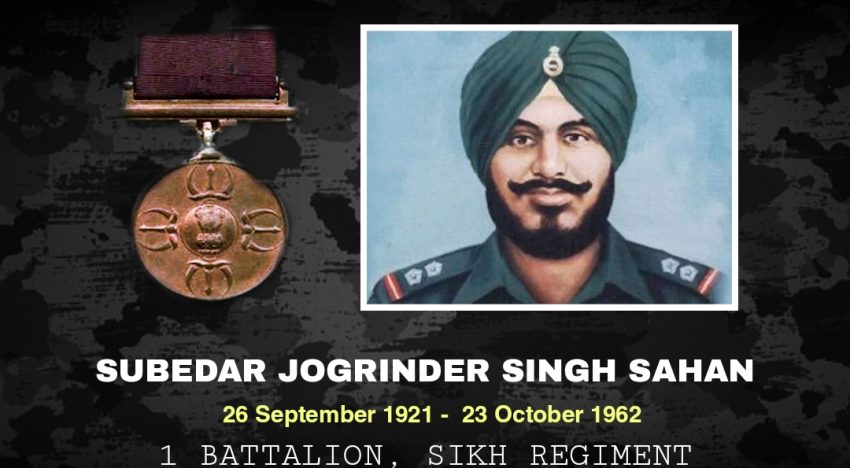Subedar Joginder Singh Sahnan was awarded the Indian military’s highest military honour, the Param Vir Chakra, was posthumously awarded to Joginder Singh Sahnan (28 September 1921 – 23 October 1962), a soldier in the Indian Army. Singh became a member of the British Indian Army in 1936, and joined the Sikh Regiment’s 1st battalion. He was in charge of a platoon at the Bum La Pass in the North-East Frontier Agency during the 1962 Sino-Indian War. Even though his group was outmatched, he nevertheless led his forces in a battle against the Chinese and fought until he was injured and captured. Singh died of his injuries while he was being held by the Chinese. He took down more than 50 Chinese soldiers and made history in the Indian Army by himself.
Early life
Joginder Singh was born on September 28, 1921, in Mahla Kalan, Moga district, Punjab, British India, to Joginder Singh and his family. He grew up in the same village where he now lives. ‘s father, Sher Singh Sahnan, was from an agricultural Saini Sikh family that had migrated to Mahla Kalan in Moga district from the hamlet Munak Kalan (which is often pronounced as Munaka) in Hoshiarpur district. Bibi Krishan Kaur Bhela was his mother’s maiden name. Joginder Singh married Bibi Gurdyal Kaur Banga, who was from a Saini family in the hamlet of Kothay Rara Singh, near Kotkapura. Bibi Gurdyal Kaur Banga was from the village of Kothay Rara Singh, near Kotkapura. He attended basic education in Nathu Ala village and middle school in Daroli village before moving to the city. He opted to enlist in the army because he believed it would provide him with a “identity and a sense of purpose.”
Military career
On joining the British Indian Army, Singh was posted to the 1st battalion of the Sikh Regiment (1 Sikh) on 28 September 1936. After joining the army, he identified his interest in education, and soon passed the Army Education Examination. He was subsequently appointed as the Unit Education Instructor. He served in the Second World War on the Burma front, and in Srinagar during the Indo-Pakistani War of 1947–1948.
Sino-India War
There had long been disagreement between India and China over disputed borders in the Himalaya region. To counter the increasing Chinese intrusions into the disputed territory, then Prime Minister of India Jawaharlal Nehru asked for strategies for dealing with them. However, the proposal put forward by the Indian Army was rejected. Instead, he approved a plan proposed by a bureaucrat called the “Forward Policy”. This called for the establishment of a number of small posts facing the Chinese positions. Due to the severe rise in public criticism against Chinese intrusions, Nehru implemented the “Forward Policy” against the advice of the army. The army’s concern was that the Chinese had a geographical advantage. Additionally, maintaining numerous small posts would be untenable if the superior Chinese forces attacked. This was ruled out by Nehru who believed the Chinese would not attack. However, the Chinese did attack and this initiated the Sino-India War.
Param Vir Chakra
Though being heavily outnumbered, Singh led his men, and kept their morale up, in the face of enemy. For his action of gallantry on 23 October 1962, he was awarded the Param Vir Chakra. The citation reads:
Subedar Joginder Singh was the commander of a platoon of the Sikh Regiment holding a defensive position at a ridge near Tongpen La in NEFA. At 0530 hours on 23 October 1962, the Chinese opened a very heavy attack on the Bum la axis with the intention of breaking through to Towang. The leading battalion of the enemy attacked the ridge in three waves, each about 200 strong. Subedar Joginder Singh and his men mowed down the first wave, and the enemy was temporarily halted by the heavy losses it suffered. With in a few minutes, a second wave came over and was dealt with similarly. But the platoon had, by then, lost half its men. Subedar Joginder Singh was wounded in the thigh but refused to be evacuated. Under his inspiring leadership the platoon stubbornly held its ground and would not withdraw. Meanwhile the position was attacked for the third time. Subedar Joginder Singh himself manned a light machine-gun and shot down a number of the enemy. The Chinese however continued to advance despite heavy losses. When the situation became untenable Subedar Joginder Singh and the few men that were left in the position fixed bayonets and charged the advancing Chinese, bayoneting a number of them before he and his comrades were overpowered. Throughout this action, Subedar joginder Singh displayed devotion to duty, inspiring leadership and bravery of the highest order.
— Gazette of India Notification No.68—Press/62,
In the 1980s, the Shipping Corporation of India (SCI), a Government of India company administered by the Ministry of Shipping, dedicated fifteen of its crude oil tankers to PVC recipients. SCI received the tanker MT Subedar Joginder Singh, PVC in 1984. It operated for 25 years before being phased out. In memory of Singh, a memorial statue has been erected opposite the District Collector’s Office in Moga, while the Indian Army has erected a monument at IB Ridge.




